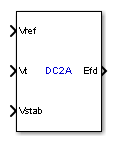DC2A Excitation System
Implements IEEE type DC2A excitation system model
Library
Simscape / Electrical / Specialized Power Systems / Electrical Machines / Synchronous Machine Control
Description
This block models a field controlled dc-commutator exciter with continuously acting voltage regulators supplied from the generator or auxiliaries bus voltage. The voltage regulator output limits are proportional to terminal voltage Vt.
This block is an adaptation of the DC2A excitation system of the IEEE® 421 standard, copyright IEEE 2005, all rights reserved.
Parameters
Controllers Tab
- Low-pass filter time constant
The time constant Tr of the first-order system representing the stator terminal voltage transducer. Default is
20e-3.- Voltage regulator gain and time constant
The gain Ka and time constant Ta of the first-order system representing the main regulator. Default is
[46 0.06].- Voltage regulator output limits
The voltage regulator output limits VRmin and VRmax, in p.u. Default is
[-4.9 4.95].- Damping filter gain and time constant
The gain Kf and time constant Tf of the first-order system representing the derivative feedback. Default is
[0.05 1.5].- Transient gain reduction lead and lag time constants
The time constants Tb and Tc of the first-order system representing the lead-lag compensator. Default is
[0 0].
Exciter and Rectifier Tab
- Exciter gain and time constant
The gain Ke and time constant Te of the first-order system representing the exciter. Default is
[0.05 0.46].- Field voltage values
The exciter saturation function is defined as a multiplier of exciter alternator output voltage to represent the increase in exciter excitation requirements due to saturation [1]. The saturation function is determined by specifying two voltage points, Efd1 and Efd2 in p.u, on the air-gap line and Constant Resistance Load Saturation curve, and providing the corresponding two saturation multipliers SeEfd1 and SeEfd2 Default is
[3.05 2.29].Typically, the voltage Efd1 is a value near the expected exciter maximum output voltage. The Efd2 value is about 75% of Efd1.
- Exciter saturation function values
The exciter saturation function is defined as a multiplier of exciter alternator output voltage to represent the increase in exciter excitation requirements due to saturation. The saturation function is determined by specifying two voltage points, Efd1 and Efd2 in p.u., on the air-gap line and Constant Resistance Load saturation curve, and providing the corresponding two saturation multipliers SeEfd1 and SeEfd2. Default is
[0.279 0.117].SeEfd1 and SeEfd2 multipliers are equal to A-B / B, A is the value of exciter field current on the Constant Resistance Load saturation curve corresponding to the selected Efd voltage, and B the value of exciter field current on the air-gap line corresponding to the selected Efd voltage [1].
If you do not want to model the saturation effect, set SeVe1 and SeVe2 values to zero.
Initial Values Tab
- Initial values of terminal voltage and field voltage
The initial values of terminal voltage Vt0 and field voltage Efd0, both in p.u. Initial terminal voltage is normally set to 1 pu. The Vt0 and Efd0 values can be determined using the Powergui Load Flow tool. Default is
[1 1].- Sample time
Specify a value greater than zero to discretize the block at the given sample time. Set to -1 to inherit the simulation type and sample time parameters of the Powergui block. Default is
0.
Ports
- Vref
The reference value of the stator terminal voltage, in p.u.
- Vt
The measured value in p.u. of the stator terminal voltage of the controlled Synchronous Machine block.
- Vstab
Connect this input to a power system stabilizer to provide additional stabilization of power system oscillations. When you do not use this option, connect to a Simulink® ground block. The input is in p.u.
- Efd
The field voltage to apply to the
Vfinput of the controlled Synchronous Machine block. The output is in p.u.
References
[1] “IEEE Recommended Practice for Excitation System Models for Power System Stability Studies.” IEEE Standard, Vol. 421, No. 5, 2005 (Revision of IEEE 521.5-1992).
Version History
Introduced before R2006a

